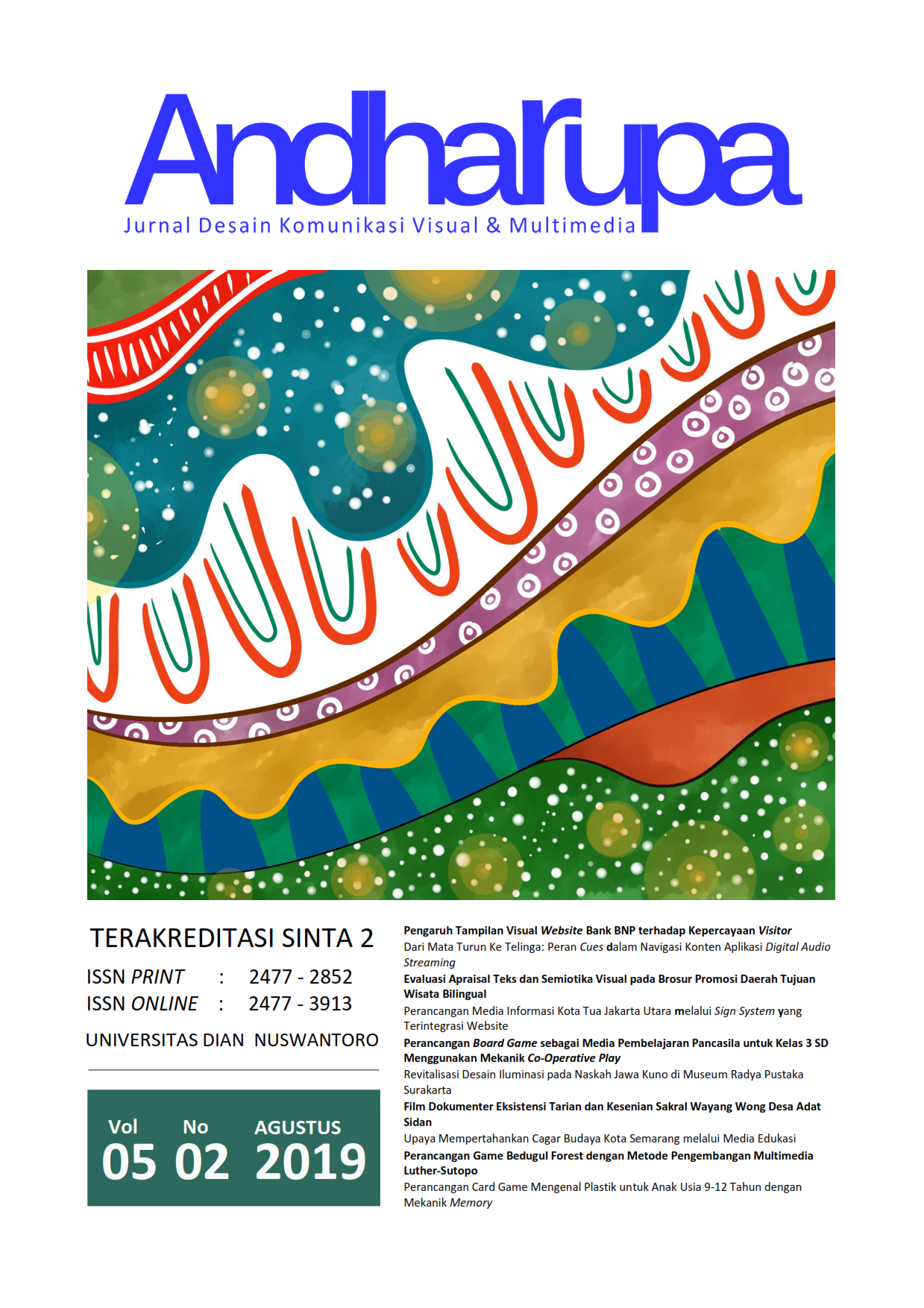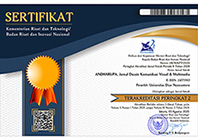PENGARUH TAMPILAN VISUAL WEBSITE BANK BNP TERHADAP KEPERCAYAAN VISITOR
DOI:
https://doi.org/10.33633/andharupa.v5i2.2228Abstract
AbstrakDalam industri jasa keuangan, termasuk perbankan, kepercayaan merupakan faktor yang paling berpengaruh terutama untuk mengambil keputusan dalam menetapkan pilihannya kepada salah satu perusahaan. Kepercayaan juga menjadi penting di dalam ranah internet, terutama ketika berbicara mengenai sebuah website. Melalui tampilan visual website, visitor akan membentuk persepsi terhadap website yang dikunjunginya. Ketika persepsi positif terbentuk di dalam diri visitor, maka ia tidak ragu untuk melakukan tindakan nyata kepada penyedia layanan website seperti membagikan data pribadi atau melakukan transaksi. Penelitian ini dilakukan untuk mengetahui pengaruh tampilan visual website PT Bank Nusantara Parahyangan Tbk. (Bank BNP) menggunakan alat ukur VisAWI (simplicity, diversity, colorfulness, dan craftmanship) terhadap kepercayaan visitor. Penelitian ini menggunakan sequential explanatory mixed method. Metode pengumpulan data kuantitatif yang digunakan pada penelitian ini adalah survei dengan menggunakan alat bantu kuesioner yang disebar ke 135 responden yang memiliki usia 23-38 tahun. Sedangkan metode pengumpulan data kualitatif yang digunakan adalah wawancara terstruktur. Hasil analisa data menunjukkan bahwa tampilan visual website Bank BNP berpengaruh 42,1% terhadap kepercayaan visitor. Selain itu, tampilan visual Bank BNP juga membentuk persepsi visitor akan kinerja bank tersebut dalam dunia nyata. Dari hasil penelitian diketahui bahwa hanya craftmanship saja yang mempunyai pengaruh yang positif dan signifikan terhadap kepercayaan visitor dibandingkan dengan elemen lainnya. Kata kunci: tampilan visual, website, kepercayaan, perbankan, VisAWI AbstractIn the financial service industry, including banking, trust is the most influential factor for making decisions in choosing a company to cooperate with. Trust also becomes significant to the use of the internet, specifically websites. Through the visual appearances of a website, a visitor will form perceptions of the website. When positive perceptions are formed, a visitor will not hesitate to take action, such as sharing personal data or making transactions with the website providers. This research was conducted to determine the influence of visual appearances of the Bank BNP website on visitor trust using VisAWI (simplicity, diversity, colorfulness, and craftsmanship). The method used in this study is a sequential explanatory mixed method. The quantitative data were collected through a survey using a questionnaire tool distributed to 135 respondents who were 23-38 years old, while the qualitative data were collected through structured interviews. The data analysis showed that the visual appearances of the website had an effect of 42.1% on visitors' trust. Visual appearances of the Bank BNP website also form visitors’ perceptions of bank performance in the real world. It also can be concluded that only website craftsmanship that has a positive and significant influence on visitors’ trust. Keywords: visual appearance, website, trust, banking, VisAWIReferences
Alsudani, F., Casey, M., F. 2009. The Effect of Aesthetic on Web Credibility. People and Computers XXIII.
Asosiasi Penyelenggara Jasa Internet Indonesia. 2017. Infografis Penetrasi & Perilaku Pengguna Internet Indonesia Survey 2017, URL: https://apjii.or.id/survei2017 [Diakses pada 18 Oktober 2018]
Costa, A. L. & Kallick, B. 2008. Learning and Leading with Habits of Mind, 16 Essential Characteristic for Success. Association for Supervision & Curriculum Development.
Creswell, J. W. 2014. Research Design, United Kingdom: SAGE Publication, Inc.
Djamasbi, S., Tullis, T., Siegel, M. 2010. Generation Y, Web Desain, and Eye Tracking. International Journal of Human-Computer Studies, 68 (5), pp.307-323.
Flavian, C., Miguel, G., dan Eduardo, T. 2005. The Influence of Corporate image on Consumer Trust, Emerald,15 (4), pp.447-470.
Garcia, M. G., Carrillo-Duran, M. V., dan Jimenez, J. L. T. 2017. Online Corporate Communication: Website Usability and Content, Journal of Communication Management, 21 (2).
Graham, L. 2008. Gestalt Theory in Interactive Media Design, Journal if Humanities & Social Sciences, 2 (1).
Holmes, J., Robins, D. 2007. Aesthetics and Credibility in Web Site Design, Information Processing and Management, 44, pp.386-399.
McKnight, D. H., Choudhury, V., dan Kacmar, C. 2002. Developing and Validating Trust Measures for e-Commerce: An Integrative Typology, INFORMS, 13 (3), pp.334-359.
Mitra, B., Webb, M., dan Wolfe, C. 2014. Audience responses to the physical appearance of television newsreader, Journal of Audience & Reception Studies, 11 (2), 45-57.
Moshagen, M., Thielsch, M. T. 2010. Facets of Visual Aesthetics, International Journal of Human-Computer Studies, 68 (10), pp.689-709.
Otoritas Jasa Keuangan. 2016. Peraturan Otoritas Jasa Keuangan Nomor 6 /Pojk.03/2016 Tentang Kegiatan Usaha Dan Jaringan Kantor Berdasarkan Modal Inti Bank, data diperoleh melalui situs internet, http://www.ojk.go.id/id/kanal/perbankan/regulasi/peraturan-ojk/Documents/Pages/pojk-kegiatan-usaha-dan-jaringan-kantor-berdasarkan-modal-inti-bank/SALINAN-POJK.6%20BUKU.pdf. [Diakses pada 4 Maret 2018]
Otoritas Jasa Keuangan. 2016. Peraturan Otoritas Jasa Keuangan Nomor 8 /POJK.04/2015 TENTANG Situs Web Emiten Atau Perusahaan Publik, URL: http://www.ojk.go.id/id/regulasi/otoritas-jasa-keuangan/peraturan-ojk/Documents/Pages/Peraturan-OJK-Nomor-8-POJK-04-2015-tentang-Situs-Web-Emiten-atau-Perusahaan-Publik/peraturan-ojk-nomor-8-pojk-04-2015-tentang-situs-web-emiten-atau-perusahaan-publik%2001.pdf. [Diakses pada 4 Maret 2018]
Otoritas Jasa Keuangan. 2017. Statistik Perbankan Indonesia., data diperoleh melalui situs internet, http://www.ojk.go.id/id/kanal/perbankan/data-dan-statistik/statistik-perbankan-indonesia/Documents/Pages/Statistik-Perbankan-Indonesia---Desember-2017/SPI%20Desember%202017.pdf. [Diakses pada 14 Maret 2018]
Praxmer, S., Rossiter, J. R. 2009. Physically Attractive Presenter and Persuasion: An Experimental Investigation of Alternative Explanation for the “Patzer Effectâ€, 8th International Conference on Research in Advertising (ICORIA).
PricewaterhouseCoopers Indonesia. 2018. 2018 Indonesia Banking Survey. URL https://www.pwc.com/id/en/publications/assets/financialservices/2018-indonesia-banking-survey.pdf. [Diakses pada 18 Oktober 2018]
PricewaterhouseCoopers Indonesia. 2018. Digital Banking in Indonesia 2018. URL https://www.pwc.com/id/en/publications/assets/financialservices/digital-banking-survey-2018-pwcid.pdf. [Diakses pada 18 Oktober 2018]
Rompf, S. 2012. Trust and Adaptive Rationality Towards a New Paradigm in Trust Research. Disertasi Program Doktor Ilmu Sosial: Universitas Mannheim.
Sabar, S. 2013. What’s a Gestalt?, Gestalt Review, 17(1), 6 – 34.
Sugiyono. 2018. Metode Penelitian Kuantitatif, Kualitatif dan R&D, Bandung: Alfabeta.
Ward, M. O., Grinstein, G., dan Keim, D. 2015. Interactive Data Visualization, CRC Press, New York, 73 - 74.
Wagemans, J., Kubovy, M., Peterson, M. A., Elder, J. H., Palmer, S. E., dan Singh, M. 2012. A Century of Gestalt Psychology in Visual Perception: I. Perceptual Grouping and Figure-Ground Organization, American Psychology Association, 138 (6), pp.1172-1217.
Downloads
Published
Issue
Section
License
Copyright (c) 2019 ANDHARUPA: Jurnal Desain Komunikasi Visual & Multimedia

This work is licensed under a Creative Commons Attribution 4.0 International License.
Authors who publish with this journal agree to the following terms:
- Authors retain copyright and grant the journal right of first publication with the work simultaneously licensed under a Creative Commons Attribution License that allows others to share the work with an acknowledgment of the work's authorship and initial publication in this journal.
- Authors are able to enter into separate, additional contractual arrangements for the non-exclusive distribution of the journal's published version of the work (e.g., post it to an institutional repository or publish it in a book), with an acknowledgment of its initial publication in this journal.
- Authors are permitted and encouraged to post their work online (e.g., in institutional repositories or on their website) prior to and during the submission process, as it can lead to productive exchanges, as well as earlier and greater citation of published work (See The Effect of Open Access).















